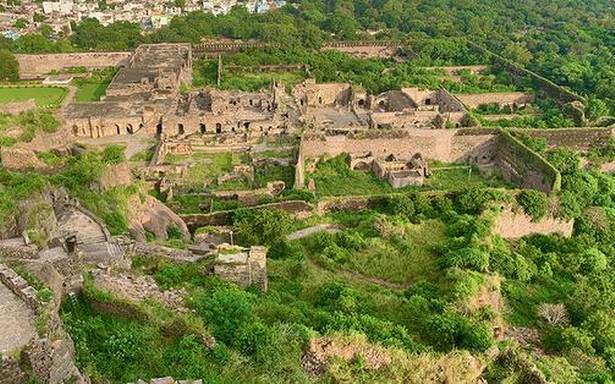The Archaeological Survey of India (ASI), according to legal filings, has brought 153 instances of encroachments inside the medieval Golconda Fort to the notice of the State government in a 10-year period between 2010 and now.
“Our staff is scared to even inspect some locations and we seek police help. We send notices. And the encroachers tear up the notices,” an ASI official told this reporter earlier when asked about the runaway encroachments inside the Golconda Fort. The result? Satellite imagery shows that the scattered patchwork of houses in 2003 surrounding the inner Golconda Fort look like a dense quilt in 2020.
An August 5, 1985, notification of the Department of Culture spells out the Golconda Fort area to include: “Golconda fort comprising citadel, outer fortification walls, gateways and other ancient structures including Naya Qila and Qutab Shahi Mahal together with government land lying between the inner citadel and outer fortification wall.” It also included all private land within the fort.
But in the absence of detailed revenue maps, ASI officials say they are helpless.
Strong political backing has made the encroachers fearless.
Even the first Qutb Shahi masjid build by Sultan Quli has not been spared and parts of it have disappeared over the last three years. Even the new entrance plaza built after 2018 has been hobbled by encroachments near the so-called Murda Darwaza. The saddest commentary about the ASI’s control over the monument is the staff quarters which have been turned into rubbish heaps by the residents of the surrounding area.
While encroachments have bedevilled the Golconda Fort for a long time, the upkeep of the inner fort has been hampered by fund crunch and ad hoc policies.
“There is no work. No strategy, no plans, no expertise all ad hoc,” says a conservation architect unwilling to go on record.
Visitors entering through the Mecca Darwaza have to look towards the Bala Hissar (high citadel) to notice two portions where the wall has collapsed. The fortified walls collapsed as the loosened lime mortar and mud gave way under the impact of the monsoon of 2020.
The Majnu Burj collapsed in the rain as the rock under it was chiselled tilting the massive brass cannon on the bastion.
While the ASI has restored large portions of the Golconda Fort giving shape using the rock debris the sprawling complex. The Mulla Khayali Mosque, Darbar Hall, Mosque, Akkanna Madanna Record Office, Naubatkhana and other structures now have a shape that was missing sometime back.
The funding for ASI was trimmed due to the COVID-19 pandemic.
The Ministry of Culture’s budget was cut by 15% from ₹3,149.86 crore allocation in 20-21 to ₹2211.85 crore actuals. The ASI’s budget has seen a dip from ₹1,247 crore allocation in 20-21 to ₹1,042 crore in 21-22 — a decline of 16%. These budgetary cuts have had a direct impact on the conservation work of ASI as the other expenses of the department like salary, pensions and overhead costs remain constant.


